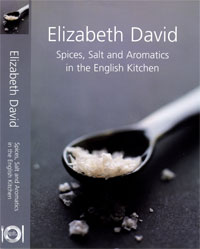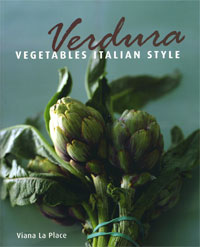Book Reviews
Spices, Salt and Aromatics in the English Kitchen, by Elizabeth David
(Grubb Street; hardback, 280pp; stg £12.99).
 It is always a pleasure to see classic cookbooks coming out again in shiny new covers and specialist publishers Grubb Street have some treats lined up for us in the coming months - Elizabeth David fans, in particular, will enjoy seeing some of her titles again, along with some other favourite kitchen classics.
It is always a pleasure to see classic cookbooks coming out again in shiny new covers and specialist publishers Grubb Street have some treats lined up for us in the coming months - Elizabeth David fans, in particular, will enjoy seeing some of her titles again, along with some other favourite kitchen classics.
Elizabeth David’s books have never been difficult to obtain, but there is something very satisfying about seeing one fresh from the printer – a smallish, squat little hardback, and not so much a drawing in sight, never mind the statement photography that is de rigeur today. A reminder, if ever there was one, that cookbooks were until recently meant for reading (and digesting), rather than looking at.
Although Elizabeth David was very much a post-war writer, her popularity has never waned and her books have as much relevance as ever today - maybe more so for the practical cook, as so many of the ingredients for her recipes were unavailable to most people at the time when they were written.
A reminder, perhaps, that the best cookbooks are all to do with ideas, memories, and hope for the future – and, while Elizabeth David is mainly associated with ‘the continent’ (which typically meant down to earth, deeply flavoursome French food and the warmth and colour of Mediterranean cooking), she wrote to be read as much as to inspire people to cook from the recipes she collected – she was also interested in the British table.
Spices, Salt and Aromatics in the English Kitchen is a late work and, through its enlightening text and wide ranging recipes, it tells a story of what Elizabeth David described as 'the English love affair with Eastern food and Arabian Nights ingredients.'
It is an interesting contradiction that a people who have a reputation for ‘plain food’ should have taken such extreme measures down through the centuries to acquire spices – so, in this book (which was to have been the first volume in a series of works on English Cooking Ancient and Modern), she examines the English preoccupation with the spices, the fruit, the flavourings, sauces and condiments of the orient near and far.
The origins and uses of ingredients such as nutmeg, cardamom and juniper are explained, also the influence of centuries of oriental trade on the English kitchen, where spices and Indian curries, kebabs and yoghurt are now perfectly at home, along with dishes such as risotto and paella.
And, of course, you will find recipes for briskets and spiced beef, smoked fish, cured pork and sweet fruit pickles – all recipes that we now think of as ‘typically English’.
Verdura, Vegetables Italian Style by Viana La Place
Grubb Street; paperback; 320pp; stg£12.99. Publication 29th July 2010
 What a lovely time of year to be reminded of this classic book celebrating the joys of seasonal vegetables – if you’re not already familiar with Viana La Place's Verdura, which was first published in America in 1991, just think ‘River Café style’: Rose Gray says on the back cover ‘Verdura is one of the cookbooks we refer to almost every day…a must-have book for all of us who love Italian food.’
What a lovely time of year to be reminded of this classic book celebrating the joys of seasonal vegetables – if you’re not already familiar with Viana La Place's Verdura, which was first published in America in 1991, just think ‘River Café style’: Rose Gray says on the back cover ‘Verdura is one of the cookbooks we refer to almost every day…a must-have book for all of us who love Italian food.’
Another simply presented book – its bigger format and two-colour design are more contemporary than the Elizabeth David books, but a long way from the colour-heavy books that weigh down the shelves today – Verdura celebrates fresh ingredients simply treated, and is very much in tune with the way the farmers’ market and allotment-holding generation is thinking today.
The book begins with a vegetable and herb guide and an ingredient glossary, also a range of menu suggestions, for different seasons and occasions.
Through its 300 or so detailed recipes La Place eases the reader (particularly the American reader) into the earthy Italian way of thinking about food, often using familiar vegetables such as artichokes, aubergines and radicchio but also introducing some that may be new to us, like chayote, cardoons, and brocciflower (this cauliflower-broccoli hybrid she sautés in garlic and oil, then tops it with pungent provolone).
The range of recipes is wide - antipastos, salads, soups, sandwiches, pasta, risottos, pizzas, and much more (including a great chapter on bread dishes and sandwiches) - and desserts are also included: anyone for Grilled Figs with Honey and Walnuts?
Summer Minestrone with Rice
Minestrone Estivo di Riso
Minestrone is so strongly associated with winter that it may come as a surprise that it is also eaten during the summer months. In warm weather, it is served at room temperature with a generous amount of fresh basil stirred into it. A special feature of this recipe is the big spoonful of sweet, rich sun-dried tomato paste that is added as the soup cooks. This soup thickens as it cools, becoming quite dense and not a bit brothy. Get a big spoon and dig in.
Click for recipe






There are currently no comments
Leave a comment
Not a member? Register for your free membership now!
Or leave a comment by logging in with: